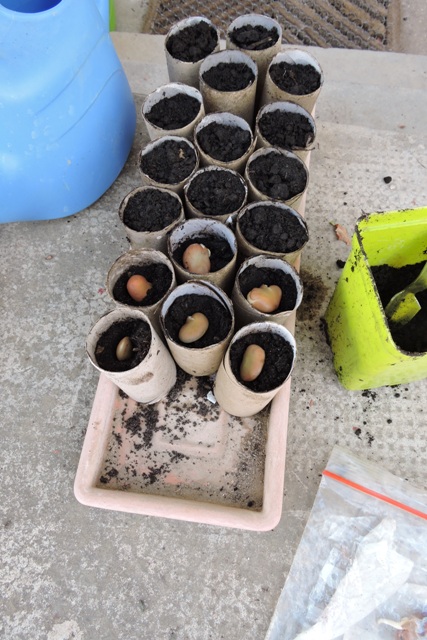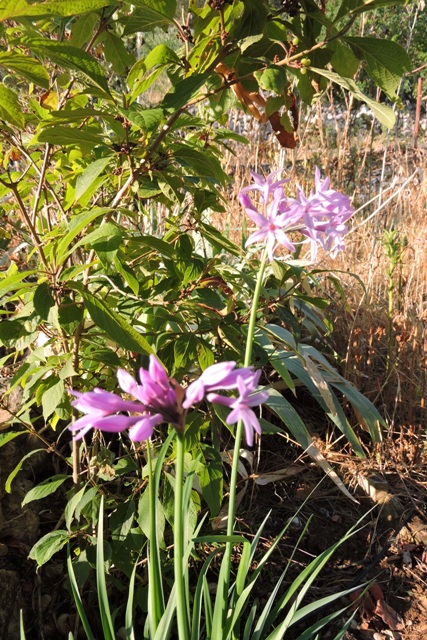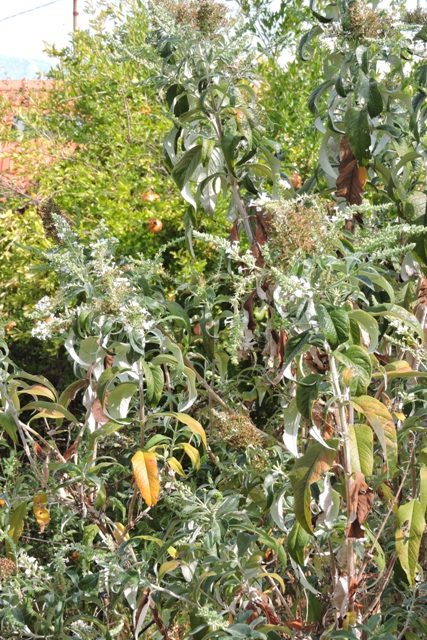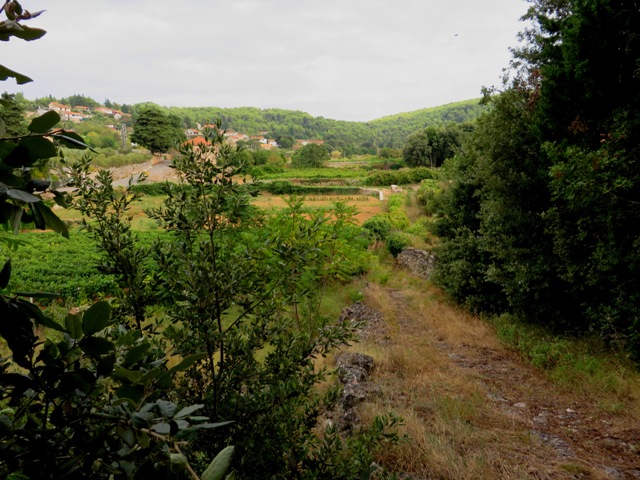A Foul Madame at breakfast time
This week: Marking out plans; A Foul Madame at breakfast time; DiY Archaeology; Autumn flowers; Potting on; Looking back;

I have big outdoors around my home. I like the big outdoors, which is why when I saw this cartoon, it made me laugh.

I do collect things too, but only in moderation, you understand….
On Monday I was outdoors at 6.15 am. I needed to get everything ready for the builder when he arrived to start work on pointing the stonework in the Konoba.
One thing I like is a nice, neat, well ordered work environment. I don’t always have one, but that is a story for another day…
Since COVID stopped my building work in early June, I have been storing all the builder’s equipment in the Konoba.
There were tools, several bags of cement, lime, mixing buckets, hose pipes and miscellaneous other assorted items, all neatly stacked.

Before the sun came up over the hill called Hum to the east, I was moving everything out of the Konoba and into place in the courtyard, ready for their arrival.
The sun crept up over the hill crest and began to warm another day, just as I removed the black plastic cover from the pile of white “nula” sand, outside my gate.

This protective sheeting has stopped the rain, the neighbours dogs and my felines from playing in and making a mess of the clean pile of sand.
The cover went in a plastic bag and I took it to the recycle bin.
7.30 came and I had breakfast, then at 8am I heard the builder’s pickup.
Špiro blithely announced that he would not be starting the job “today”. Apparently because one of his workers had not returned from holiday and the other had to go and take his motorcycle to the vehicle test centre in Vrbanj.
He shrugged his shoulders and with a wave departed, saying he “might” be here in the morning….
A little later I saw a neighbour to whom I related what had happened, finishing with the comment, “…but hey! This is Croatia!”
He immediatley and forcefully corrected me saying this is NOT Croatia, this is an attitude which is peculiar to the island.
In Zagreb, where he comes from, he said the workmen who didn’t turn up would have been fired.
It is just another example of how island life can be immensely frustrating.
This laisser-faire attitude is something that you can only only experience once you are living here.
No amount of research into a country shows up this kind of event, which you can only find out about once you are living in a community.
It is not something which anyone tells you about in advance!
That said, the sun has been shining all week. The days and the sea are still warm and the Cicadas are still chirping.
Although it is now well into autumn, all is well with the world – except for Climate Breakdown of course…
Marking out plans
I cannot recall the number of times in my professional career that I have been asked “Do you have a plan?”, but it would be a considerable number.
The answer was of course always “Yes”, even if the plan was still being hatched.
Then later as an emergency and event planner…, well the clue is in the word “planner”.
So I do tend to plan things. Perhaps not to the same level of detail that I would have done for a Royal visit though.
I make plans, usually in pencil on paper. Pencil makes making changes easier and because it helps me to think through possible pitfalls.
A hard copy plan also makes the actual execution of a job a little easier.
In the top orchard, my first plan was to locate where fruit trees would go, with only a sketchy outline of how I would then fit in things around them.

Trees take a while to establish, so planting them early meant that I could then get on with other, more pressing, building work.
The trees are now established and some are even providing fruit. They still need irrigating though, because of the breakdown of the annual and seasonal rainfall pattern.
A couple of years ago I rebuilt the access to the orchard, building stone steps and incorporating rainfall recovery pipes.
This is so that instead of roof rainfall just running to ground, it would be directed to an area where is it needed.
As I extended the shrubbery along the boundary, I also included underground irrigation pipes, but I didn’t complete the circuit.
Now after close to five months of spending time every morning and evening irrigating trees and shrub in the orchard by hand, I have decided that I really should complete the circuit.
What I will do over the winter is to extend the pipe system and then make it automatic before next year’s dry season.
I also would like to continue extending the ‘all weather’ path down the length of the orchard.
This week I began by marking out the path, in a nice flowing line.
This is so that someone walking into the orchard will get a series of self contained “vistas” as they advance along the path.
Next it was using a spade to confirm the line of the path by digging out along the edge.

The path will be lined with rockery stones.
I realised there will be a lot of soil to move and riddle for stones. So I decided to follow my OHIO principle and bring the rotary riddle down to the site, then I am only digging out once.
A Foul Madame at breakfast time
I saw a story line on the BBC this week, about a man who has eaten the same breakfast, a “full English”, every morning, for the past 22 years.

It does go to prove that you can have too much of a good thing!
Breakfast tastes vary as you travel around the world.
Different parts of the country have different traditions. Here in Dalmatia it would probably be very fresh bread and pašteta, maybe a fresh burek from the bakery and of course coffee. Lots of coffee….
I eat “healthily” all the time and have done for years so a “Full English” is not to my taste.
What I did enjoy during my time on the Arabian Peninsula was the Arabic Ful Mudammas, [AR: فول مدمس] , anglicised to Foul Medames.
I should say that there is nothing foul about them.

The dish is made from the Fava bean, Vicia faba, better known in English speaking countries as the “broad bean”.
These beans have been found in Mediterranean archaeological sites going back to 3,000 BCE, so they are very much from this part of the world.
I’ve planted my winter crop of Fava Beans, although not in the soil just yet.
I started the seeds by soaking them in luke warm water for 24 hours. I then transferred them to a sealed plastic bag, with damp kitchen paper inside, and put them in the microwave.

This is somewhere which is dark and warm – I just had to remember NOT to switch it on!
I was looking for the Radicle root swellings to appear, then I’d plant them in cardboard tubes, before they go outside.
I’m not sure whether I will get a winter crop this year. It depends on how cold the winter is and when winter arrives.
However, if I don’t try, I won’t find out.
Two days after going in the bag, most of the bean seeds have their Radicle, some are already almost 10mm long. Only one seed failed to germinate.


The next job was to fill some carboard tubes with soil, moisten them and then put them in the sunshine to warm.

After an hour or so, I started carefully planting the beans.

The whole tray then went into the greenhouse.
I’m not putting the tray in the propagator as it is too warm. So I will leave them on a shelf and wait for the Cotyledon and then first leaves to appear.
The radicles have been planted facing down into the soil. so they are growing in the right direction. Then I put four additional tubes in the propagator, just to see what happens.
The rest are on the top rail in the greenhouse.
Fava beans are extremely hardy. So depending where you are in the world, they can be planted to overwinter, six to eight weeks before the shortest day of the year.
While the soil is still warm, the seeds will germinate and grow, before winter cold stops development. Then in the spring as the days lengthen, they will continue their growth cycle.
This will reward you with an early crop of greens for your kitchen.
If you have some old seeds and want to find out if they are still viable, try the soaking and plastic bag method to see how many germinate.
DiY Archaeology
As time passes I find myself becoming more and more interested in the archaeology of my home.
This week I have had the use of the builders Makita HM0860C small electric breaking hammer.
I have achieved in a week with this device what I failed in achieve using my power tools over several weeks in June.
That was before I aggravated an old wrist injury using my heavy power tools.
It does show that having the correct tool for the job does make things a lot simpler.
The wall in question is the non-load bearing divider in the cottage ground floor rooms.

It is in two very clear parts, built by different people and at different times.
What I couldn’t identify was why. I think now I have answered that conundrum.
There is a very old wall held together with soft lime mortar. This breaks easily and the dust that is created is significant.
Then there is, or rather was, a second wall behind, held together with concrete.
This has been the one I have struggled to break up. That is until I started using the Makita.
As I broke the wall down, I could see that neither wall had been lapped into the external walls. So originally this had been a single room building.
Outside there is the hitch for a donkey and you can discern an arch entry which has been filled in.

But what I saw as I was able to break the concrete was that the new wall had been added later, to cover the water supply pipe and the old electric cables.
There is a mark on the wall by the door where the old wall ended and the whitewash started.

Today on the island there is a technique builders used to make walls where a strong concrete mix is added in, around and crucially behind stones.
A wooden shutter at the back holds the concrete in place until it has set and the stones plus concrete become self supporting, without further reinforcement.
Mains water only came to the village in the 1980’s and electricity in the decade before.
So my exposure of the wall this week has shown that when the water pipes were laid, rather than cutting a channel in the existing wall, it was easier to just build a new, outer wall, encasing the pipes.
There was just 18 cm of space, so stones were laid vertically in concrete. This was then packed in behind and has stuck to what was then the bare stone face of the original wall.
The white on the back of the wall in this photograph is the lime wash from the old stone faces, now attached to the concrete.

This is why it has been so difficult to break it all apart. I now just have a few bits of stone, some plaster and a lot of dust to move.

Now where did I leave my wheelbarrow…..?
Autumn flowers
There are some bulbs which are classed as “Autumn flowering”. These only come into bloom when the day length is shortening and the temperatures are cooling.
I have a few autumn bulbs, although not as many as I would like because they make a nice display.
These are in the border of the Drupe orchard.

Suddenly they have burst into growth and then this week the first flower spikes have appeared.
Judging by the amount of foliage, I will be able to dig them up and split the clump next year.

Close by, although a citrus not a drupe, is my Kumquat, which has also produced blossom this week. The small fruits will be ready for picking in April next year.

This is one of the strange citrus varieties which produce small egg shaped fruits that are eaten whole, peel and everything.
With the minerals and vitamins in the skin, they are very healthy.
I have managed to keep one of my nice weeds alive this year with daily waterings.
“A weed is just a plant in the wrong place”, is an oft quoted maxim on the BBC Gardner’s Question Time radio programme.
The quotation is attributed to George Washington Carver, an American horticulturist but has been repeated so often, by so many people that no one is now really sure of the true source.
However, the saying is a truism. I have a number of “pretty weeds” and my Buddlejas are one.
In several parts of the world, the Buddleja is classed as an invasive species. Here on my land, it struggles to survive.
However, after the recent rainfall, one of my varieties with cerise coloured flowers has bloomed for the first time this year.

I also have a white Buddleja. This variety does not seem to have been affected as badly by the lack of rain and has been flowering since June.

Throughout the summer the flower racine’s have been smaller than in previous years though.
One bulb which is just about surviving is my Autumn Crocus.

Just a couple of flowers appear each year, but the bulbs do not seem to be multiplying.
Surviving rather than thriving is how I would describe its existence, though it is a native to central-southern Europe.
One plant which will continue to produce blooms until the first really cold nights is my Passion Flower. Here being lit with the first rays of today’s morning sun.

Potting on
I have a planter full of white pine berries, Pineberry White Dream, which this year have produced a lot of fruit.
This autumn, the plants have produced dozens of runners, so I have been potting them up this week.
Some of the runners have gone into individual pots and others I have laid in long planters.
The original plants were positioned to get morning sun and then shade from the mid-day sun.

This is a variety which has enjoyed the summer heat. I have been irrigating the planter and will use some of the rooted plants next year outside in one of the orchards, in a similar position.
There are 35 individual runners. If I get 25 which root I will be more than happy.
Often I think it is luck rather than good judgement which allows one of my plantings to thrive in what has to be described as a ‘harsh Mediterranean climate’. NCG
Looking back – Week 36
This is the start of the weekly section with links to past year’s issues of the blog.
2014/36 heading

2015/36 heading

2016/36 How do you eat an elephant

2017/36 I’ve started so I’ll Finish
2018/36 Well clarted boots

2019/36 Digging for Brown Gold

2020/36 Many uses for a blue light

One Response
John Bailey
Enjoyable read this week Norman. Sorry to hear you were let down by the builder.